Over the last few months, falling interest rates, falling prices, and rising rents have made payment affordability hit an eleven-year high.
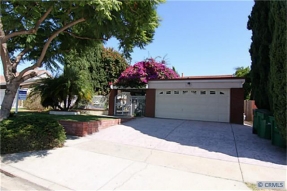
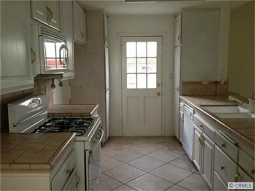
Irvine Home Address … 14772 DONCASTER Rd Irvine, CA 92604
Resale Home Price …… $505,000

Work it harder,
make it better
Do it faster,
makes us stronger
More than ever,
Hour after
Our work is never over
Daft Punk — Harder, Better, Faster, Stronger Lyrics
For the first time in the nearly five years I have been writing for this blog, prices across most of Irvine are trading at or below rental parity. There are significant market headwinds which will likely prevent house prices from moving higher, so relatively affordable prices may be with us for a while, and I think that is great news.
Today, we are going to take a detailed look at the Irvine data. This is the same data I present in our monthly OC housing market presentations. We will be taking December off, but we will be back in January to provide a live presentation of the current market data.
Months of Supply

In October and November, months of supply typically increases. Many sellers keep their homes on the market hoping for a late-year sale, but the demand dries up. With low demand and large supply, the months-of-supply calculations move much higher. The market is undeniably weak, but these numbers make circumstances look worse than they really are.
The importance of rental parity
I write frequently about rental parity because it represents the threshold of affordability. When prices are above rental parity, it costs more to own than to rent, so owning is not a wise financial decision. Owning may still be right for people, and many are willing to pay the premium to own to obtain the emotional benefits of ownership; however, on a purely financial basis, paying more than rental parity is generally not wise.
When prices are below rental parity, it costs less to own than to rent, so owning under these circumstances is generally a wise choice. Since a buyer who pays less than rental parity for a house is saving money, there is a clear financial benefit obtained irrespective of fluctuations in resale price.
When the cost of ownership is less than rental parity, an owner is far less likely to be forced to sell at a loss. The property can always be rented to cover costs rather than sell for a loss. Further, this ability to rent and at least break even provides the owner with flexibility to move if necessary. Mobility to take a new job or buy a different house is denied to those who overpaid and who are stuck paying more in the cost of ownership than they can obtain in rent.
With these advantages, buying at a price below rental parity using fixed-rate financing is critical. Every buyer should consider rental parity in their buying decision.
How rental parity is calculated
Each month I calculate rental parity using aggregate data from the MLS. It requires two data points to make the calculation:
- Average rental rate
- Current mortgage interest rate on 30-year fixed-rate loans.
I also make some key assumptions.
First, as mentioned previously, I assume a 30-year fixed-rate mortgage. It's the only mortgage product which provides sufficient payment stability to ensure the property will always be affordable.
Second, only a percentage of the rent can be put toward a mortgage payment. It's not as simple as assuming the rent equals the payment.
The payment is generally smaller than the actual cost of ownership (today's featured property is a rare exception). The cost of ownership usually includes other costs like HOA dues, Mello Roos, maintenance expenses, and insurance. These costs erode the buying power of the rental payment. There are offsets with tax breaks and loan amortization, but generally, the cost of ownership is bigger than the payment.
Conventional financing
There are two assumptions which change depending on the type of financing used. A buyer using conventional financing does not pay private mortgage insurance or FHA insurance premiums. This means the cost of ownership is much closer to the actual payment. Or looked at another way, the rent which would be applied to the payment would be higher. When I make these calculations, I assume 90% of the rent could go toward making a loan payment. In areas with no HOAs or Mello Roos (like today's featured property) that assumption is too low, but in areas where the HOA and Mello Roos is high, the assumption is too high.
I take 90% of the aggregate rent as a potential loan payment. I calculate the mortgage balance such a payment would service at today's interest rate. The result is the loan component of rental parity. To the loan balance, I add an appropriate down payment. For conventional buyers, the down payment applied is 20%.
For example, if an area or zip code has an aggregate rent of $2,500 — a common number in Irvine — I will assume $2,250 is available to make a mortgage payment. At 4% interest, a $2,250 payment would service an astounding $471,288. If $471,288 were the loan balance, the down payment would be $117,822. The sum of those two is $589,110 which represents the rental parity equivalent of a $2,250 payment applied to a 4% fixed-rate mortgage using conventional terms.
FHA financing
FHA financing yields very different results, so I track both of these separately. The two main differences are the mortgage insurance and the lesser down payment. With FHA financing, I assume only 75% of the rent goes toward the loan payment, and the down payment is only 3.5%.
In the example above, the $2,500 rent yields only $1,875 toward a loan payment. At 4% interest, a $1,875 payment only services $392,740. Further, a 3.5% down payment means the borrower is only adding $14,244 to the loan balance. The resulting rental parity for an FHA buyer is only $404,984 instead of the $589,110 for the conventional buyer.
The added costs and smaller down payments make houses much less affordable for FHA borrowers than they are for conventional borrowers. It's the main reason Irvine and other move-up communities are maintaining higher prices while those communities dominated by FHA financing are experiencing more serious declines.
Data for buyers using conventional financing
The following two graphics show the state of house prices relative to rental parity for buyers using conventional financing in Irvine, CA. Notice that prices are the lowest relative to rental parity of any time over the last 11 years.

Nearly every zip code and Village in Irvine is at or below rental parity. The lone exceptions are the Villages in the 92603 zip code of Turtle Rock, Turtle Ridge, Quail Hill and Shady Canyon.

Data for buyers using FHA financing
The following two graphics show the state of house prices relative to rental parity for buyers using FHA financing in Irvine, CA. Prices for FHA buyers are still inflated, although the recent declines have put them at nine-year lows.


The FHA data may be a bit misleading because FHA insurance used to be much less expensive than it is today. Prices are still inflated for FHA buyers, but it may not have been quite as inflated a few years ago when FHA insurance was much more affordable.
Year-over-year percentage change
Real estate market exhibit strong seasonal patterns and a strong tendency to trend for long periods. The only way to gain an accurate understanding of what's happening in the market is to ignore the month-to-month fluctuations and focus on year-over-year changes.
Further, I prefer to look at data on a per-square-foot basis. The median is too susceptible to fluctuations based on the change of mix to be reliable. Looking at per-square-foot costs provides a more accurate picture of what buyers are obtaining for their money.

As you can see, prices are falling all over Irvine. On a per-square-foot basis, prices are down nearly 10% year-over-year, and they have been falling at that pace for the last 4 months. Much of the increase in affordability is explained by this decline in price.

The other factor which has improved the rental parity picture is a firming of rents over the last year. Rents stopped their decline in late 2010, and rents have been climbing at a slow but steady pace ever since.

The zip code showing the most weakness is still 92620 which is Northwood and Woodbury. Rents finally turned positive in the last two months after a year of steady declines.

The bottom line is that prices are falling, interest rates are falling and rents are rising. That combination of factors is making houses much more affordable, and this trend should continue through the winter until the season spring rally bumps prices up a bit.
Short-Sale and REO Workshop
Shevy Akason and Larry Roberts will host a short sale and REO workshop at 6:30 PM Wednesday, November 16, 2011, at the offices of Intercap Lending (9401 Jeronimo, Suite 200, Irvine, CA 92618).
Long term owners who went Ponzi
 The previous owners of today's featured property bought so long ago their purchase is not on my database. Their taxable basis was $93,605 which suggests they likely bought in the 1970s. By 4/6/1999 they had increased their first mortgage to $169,600. They followed by refinancing a few times including a $343,000 HELOC on 6/21/2005 and a $270,000 mortgage on 8/28/2006. The bank took the property back on 2/14/2011 for $238,000. They did get to squat for a while…
The previous owners of today's featured property bought so long ago their purchase is not on my database. Their taxable basis was $93,605 which suggests they likely bought in the 1970s. By 4/6/1999 they had increased their first mortgage to $169,600. They followed by refinancing a few times including a $343,000 HELOC on 6/21/2005 and a $270,000 mortgage on 8/28/2006. The bank took the property back on 2/14/2011 for $238,000. They did get to squat for a while…
Foreclosure Record
Recording Date: 12/01/2010
Document Type: Notice of Sale
Foreclosure Record
Recording Date: 08/12/2010
Document Type: Notice of Default
Foreclosure Record
Recording Date: 12/09/2010
Document Type: Notice of Default
Their loss is your gain
In real estate many times buyers profit at the expense of distressed or motivated sellers. The Ponzi who dumped this property on the bank is long gone, but now the bank has to deal with the property. Bank REO is, by definition, distressed property.
The point of this post is to demonstrate how affordable the combination of lower prices and low interest rates is having on affordability. Today's featured property is a 2,336 SF three bedroom two bath home with a monthly cost of ownership for a conventional buyer of $1,884. This house would certainly rent for much more than $1,884 per month.
——————————————————————————————————————————————-
This property is available for sale via the MLS.
Please contact Shevy Akason, #01836707
949.769.1599
sales@idealhomebrokers.com


Irvine House Address … 14772 DONCASTER Rd Irvine, CA 92604
Resale House Price …… $505,000

Beds: 3
Baths: 2
Sq. Ft.: 2336
$216/SF
Property Type: Residential, Single Family
Style: One Level, Traditional
Year Built: 1970
Community: El Camino Real
County: Orange
MLS#: S679315
Source: CRMLS
Status: Active
On Redfin: 2 days
——————————————————————————
BANK OWNED!!! New carpet and paint throughout. Great curb appeal, single level with lots of space for a growing family. Additional family room, dining room perfect for entertaining or easily converted to bedroom. Added wetbar. Mirrored wardrobe doors in master, nice fireplace in family room. Gated front courtyard. Close to schools, shopping and freeway. Excellent Irvine school district
——————————————————————————————————————————————-
Proprietary IHB commentary and analysis ![]()
Resale Home Price …… $505,000
House Purchase Price … $238,000
House Purchase Date …. 2/1/2011
Net Gain (Loss) ………. $236,700
Percent Change ………. 99.5%
Annual Appreciation … 93.8%
Cost of Home Ownership
————————————————-
$505,000 ………. Asking Price
$101,000 ………. 20% Down Conventional
4.06% …………… Mortgage Interest Rate
$404,000 ………. 30-Year Mortgage
$96,218 ………. Income Requirement
$1,943 ………. Monthly Mortgage Payment
$438 ………. Property Tax (@1.04%)
$0 ………. Special Taxes and Levies (Mello Roos)
$105 ………. Homeowners Insurance (@ 0.25%)
$0 ………. Private Mortgage Insurance
$0 ………. Homeowners Association Fees
============================================
$2,486 ………. Monthly Cash Outlays
-$316 ………. Tax Savings (% of Interest and Property Tax)
-$576 ………. Equity Hidden in Payment (Amortization)
$144 ………. Lost Income to Down Payment (net of taxes)
$146 ………. Maintenance and Replacement Reserves
============================================
$1,884 ………. Monthly Cost of Ownership
Cash Acquisition Demands
——————————————————————————
$5,050 ………. Furnishing and Move In @1%
$5,050 ………. Closing Costs @1%
$4,873 ………. Interest Points
$17,675 ………. Down Payment
============================================
$32,648 ………. Total Cash Costs
$39,200 ………… Emergency Cash Reserves
============================================
$71,848 ………. Total Savings Needed
——————————————————————————————————————————————————-

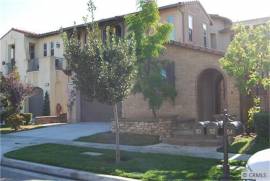
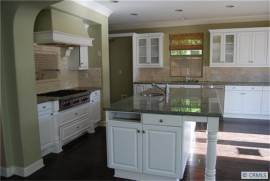





 This is a key point. Attempts to reflate a housing bubble will invariably go to another asset class. The problem with bubbles is that prices get detached from their underlying values. The inevitable crash refocuses investors on value, so even when cheap money is made available, that money will not flow into the previously inflated asset class. Instead, the cheap money will flow into some other asset class and form a bubble there. Anyone noticed how well commodities have done since housing and stocks crashed?
This is a key point. Attempts to reflate a housing bubble will invariably go to another asset class. The problem with bubbles is that prices get detached from their underlying values. The inevitable crash refocuses investors on value, so even when cheap money is made available, that money will not flow into the previously inflated asset class. Instead, the cheap money will flow into some other asset class and form a bubble there. Anyone noticed how well commodities have done since housing and stocks crashed? Everyone who wants higher prices and lower lending standards harkens back to the prices and standards of the bubble which by definition were not stable. Lending standards are not too tight today. In fact, they are still loose by pre-bubble standards. Many in the real estate industry viewed looser lending standards as a sign of innovation in finance. In reality, it was merely folly, and we are all paying the price for this epic failure.
Everyone who wants higher prices and lower lending standards harkens back to the prices and standards of the bubble which by definition were not stable. Lending standards are not too tight today. In fact, they are still loose by pre-bubble standards. Many in the real estate industry viewed looser lending standards as a sign of innovation in finance. In reality, it was merely folly, and we are all paying the price for this epic failure. She is right. realtors will always argue against removing any housing subsidy no matter the circumstances. The arguments they will make will differ, but their clamoring for subsidies will always be the same.
She is right. realtors will always argue against removing any housing subsidy no matter the circumstances. The arguments they will make will differ, but their clamoring for subsidies will always be the same.



 Beautiful Executive home in Portola Springs. This home boasts lavish upgrades. Refinished hardwood floors throughout. 3 Bedrooms suites each with its own private bath. Separate casita located off courtyard and has its own separate entrance. Sizeable bonus room upstairs. Gracious Master suite. Formal living room and dining room combo. Gpourmet kitchen w/ granite counter tops, vegetable sink in center island, glass front cabinets, breakfast bar and nook. Adjacent to the kitchen is a spacious family room w/ fireplace. Good size rear yard w/ upgraded hardscape. Eentertainers home. Additional features include 3 car garage, mud room, upstairs laundry room, plantation shutters, recessed lighting, and crown molding throughout. Must See!
Beautiful Executive home in Portola Springs. This home boasts lavish upgrades. Refinished hardwood floors throughout. 3 Bedrooms suites each with its own private bath. Separate casita located off courtyard and has its own separate entrance. Sizeable bonus room upstairs. Gracious Master suite. Formal living room and dining room combo. Gpourmet kitchen w/ granite counter tops, vegetable sink in center island, glass front cabinets, breakfast bar and nook. Adjacent to the kitchen is a spacious family room w/ fireplace. Good size rear yard w/ upgraded hardscape. Eentertainers home. Additional features include 3 car garage, mud room, upstairs laundry room, plantation shutters, recessed lighting, and crown molding throughout. Must See! 
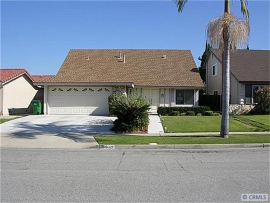






 I have no data to back this, but I speculate that jumbo borrowers are more likely to strategically default than subprime borrowers. Many subprime borrowers recognize that the subprime loan they never should have been given is their only reasonable opportunity to attain and sustain home ownership. This will motivate them to hang on tighter and sacrifice more. On the other hand, jumbo loan owners know they will be given another change to borrow and own again, so if things don't work out in their favor, they can simple walk away and start over. It is much more of a business and financial decision for a jumbo borrower.
I have no data to back this, but I speculate that jumbo borrowers are more likely to strategically default than subprime borrowers. Many subprime borrowers recognize that the subprime loan they never should have been given is their only reasonable opportunity to attain and sustain home ownership. This will motivate them to hang on tighter and sacrifice more. On the other hand, jumbo loan owners know they will be given another change to borrow and own again, so if things don't work out in their favor, they can simple walk away and start over. It is much more of a business and financial decision for a jumbo borrower.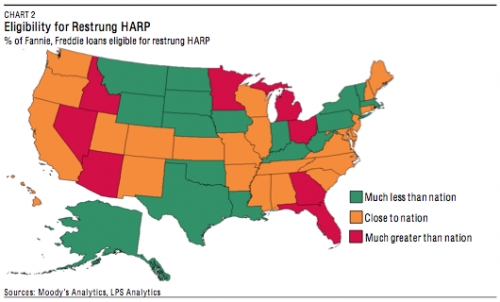










 The loans they reduce principal on are likely to be the lost causes they were going to lose anyway in a foreclosure. Most likely they will forgive part of the principal on some deeply underwater loan owners to induce them to make a few more payments. By giving false hope to the hopeless, they will actually gain a few additional payments they would otherwise miss to strategic default.
The loans they reduce principal on are likely to be the lost causes they were going to lose anyway in a foreclosure. Most likely they will forgive part of the principal on some deeply underwater loan owners to induce them to make a few more payments. By giving false hope to the hopeless, they will actually gain a few additional payments they would otherwise miss to strategic default.
 All principal reduction is a bad idea, but as I noted above, banks will use this as a loss mitigation measure to try to induce some deeply underwater loan owners to make a few more payments.
All principal reduction is a bad idea, but as I noted above, banks will use this as a loss mitigation measure to try to induce some deeply underwater loan owners to make a few more payments.
 Why is that important? Banks are going to do what's in their best interest financially. They want to keep borrowers paying. The deal doesn't have to be punitive to be effective.
Why is that important? Banks are going to do what's in their best interest financially. They want to keep borrowers paying. The deal doesn't have to be punitive to be effective.
.jpg)



.png)
